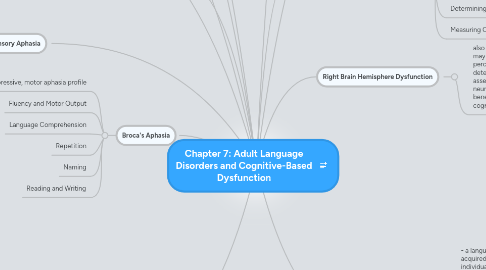Chapter 7: Adult Language Disorders and Cognitive-Based Dysfunction
by Carlee Willey


1. Conduction Aphasia
1.1. results from injury to the temporal-parietal area of the brain
1.2. fluency and motor output
1.3. Language Comprehension
1.4. Repetition
1.5. Naming
1.6. Reading and Writing
2. Wernicke's Aphasia
2.1. Language Comprehension
2.2. Fluency and Motor Output
2.3. Repetition
2.4. Naming
2.5. Reading and Writing
3. Transcortical Sensory Aphasia
3.1. classical symptoms of Wernicke's except with stellar repetition skills
4. Global Aphasia
4.1. deficits across all language modalities
5. Transcortical Motor Aphasia
5.1. slow and labored output on their own but perform reasonably on repetitive tasks
6. Broca's Aphasia
6.1. nonfluent, expressive, motor aphasia profile
6.2. Fluency and Motor Output
6.3. Language Comprehension
6.4. Repetition
6.5. Naming
6.6. Reading and Writing
7. Defining Characteristics of Aphasia Syndromes
7.1. Anomic Aphasia
7.1.1. not identified with specific area of brain or site of a lesion
